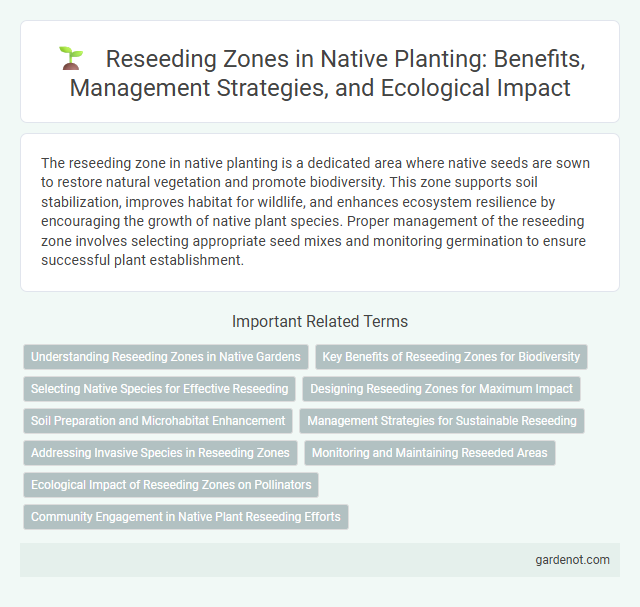The reseeding zone in native planting is a dedicated area where native seeds are sown to restore natural vegetation and promote biodiversity. This zone supports soil stabilization, improves habitat for wildlife, and enhances ecosystem resilience by encouraging the growth of native plant species. Proper management of the reseeding zone involves selecting appropriate seed mixes and monitoring germination to ensure successful plant establishment.
Understanding Reseeding Zones in Native Gardens
Reseeding zones in native gardens refer to specific areas where native plants naturally drop seeds, allowing for organic regeneration and enhanced biodiversity. Understanding these zones involves identifying soil conditions, sunlight exposure, and seed dispersal patterns that favor successful reseeding. Proper management of reseeding zones promotes sustainable growth and resilience in native plant communities.
Key Benefits of Reseeding Zones for Biodiversity
Reseeding zones significantly enhance biodiversity by providing native plants with optimal conditions for growth, leading to increased habitat complexity and food sources for local wildlife. These zones support pollinators such as bees and butterflies, crucial for ecosystem health and plant reproduction. Establishing reseeding areas helps restore native plant communities, improve soil stability, and maintain ecological balance.
Selecting Native Species for Effective Reseeding
Selecting native species for effective reseeding involves choosing plants adapted to local soil, climate, and ecological conditions, ensuring higher survival and growth rates. Emphasizing species with deep root systems and drought tolerance enhances soil stabilization and ecosystem resilience. Prioritizing biodiversity by including a mix of grasses, forbs, and shrubs supports wildlife habitats and promotes sustainable native plant communities.
Designing Reseeding Zones for Maximum Impact
Designing reseeding zones involves selecting native plant species adapted to local soil and climate conditions, ensuring higher germination rates and long-term growth success. Strategic placement of reseeding zones in areas with minimal competition from invasive species maximizes native biodiversity and ecosystem resilience. Incorporating diverse native seed mixes tailored to specific microhabitats enhances habitat complexity and supports pollinators and wildlife.
Soil Preparation and Microhabitat Enhancement
Soil preparation in reseeding zones involves loosening compacted soil and removing invasive species to promote native seed germination. Enhancing microhabitats through the addition of organic mulch and creating varied soil textures supports moisture retention and beneficial microbial activity. These practices establish optimal conditions for native plants to thrive and contribute to biodiversity restoration.
Management Strategies for Sustainable Reseeding
Effective management strategies for sustainable reseeding in native planting emphasize soil preparation, selection of appropriate native seed mixes, and timing of seed application to maximize germination rates. Maintaining adequate soil moisture and minimizing soil disturbance are critical to support seedling establishment and prevent erosion. Periodic monitoring and adaptive management ensure long-term vegetation health and resilience in the reseeding zone.
Addressing Invasive Species in Reseeding Zones
Reseeding zones targeted for native planting require proactive management to address invasive species that threaten biodiversity and ecosystem stability. Implementing selective herbicide treatments and manual removal helps create optimal conditions for native seeds to establish and thrive. Monitoring post-seeding growth ensures invasive species do not outcompete native plants, preserving the long-term health of the reseeded habitat.
Monitoring and Maintaining Reseeded Areas
Monitoring reseeded zones involves regularly inspecting plant growth, soil conditions, and moisture levels to ensure successful native vegetation establishment. Maintaining reseeded areas requires targeted watering, timely weed control, and periodic soil aeration to promote healthy root development and plant resilience. Consistent evaluation allows for early identification of issues such as pest invasion or nutrient deficiencies, facilitating prompt corrective actions that support long-term ecosystem restoration.
Ecological Impact of Reseeding Zones on Pollinators
Reseeding zones play a crucial role in restoring native plant habitats, directly benefiting pollinator populations by providing essential foraging resources and nesting sites. These zones enhance biodiversity, supporting a variety of pollinators such as bees, butterflies, and hummingbirds, which are vital for ecosystem health and crop pollination. By increasing native flora diversity, reseeding zones help maintain pollinator resilience against environmental stressors and habitat loss.
Community Engagement in Native Plant Reseeding Efforts
Engaging local communities in native plant reseeding zones enhances biodiversity restoration by fostering stewardship and knowledge sharing. Collaborative efforts with schools, volunteer groups, and indigenous organizations ensure effective seed collection, planting, and monitoring, increasing reseeding success rates. Community involvement also promotes awareness of native species' ecological benefits, supporting long-term habitat resilience and sustainability.
Reseeding zone Infographic

 gardenot.com
gardenot.com